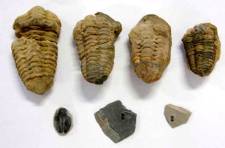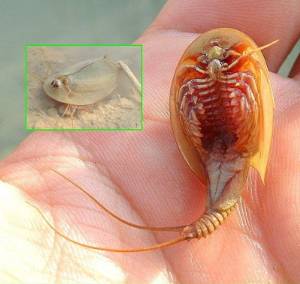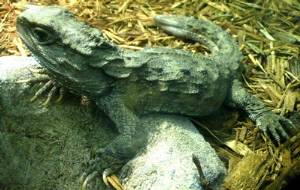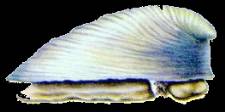On the Origins of New Forms of Life
6.5: Gould and Eldredge
EUGENE M. MCCARTHY, PHD GENETICS
|
|
(Continued from the previous page)
The battle between the gradualists and the saltationists, which is further discussed below, continued until the 1940s, when a strong intellectual shift occurred. Gradualism then became the ascendant perspective among biologists. But in the early 1970s paleontologists Stephen Jay Gould and Niles Eldredge raised the flag of saltation once again.1 Their 1972 article caused an evolutionary uproar that has not subsided to this day. As had many of their saltationist colleagues in years gone by, they emphasized that a wide variety of fossil types 1) arise suddenly and 2) are static thereafter. Gould (1980a: 182) later expressed the problem succinctly:
The history of most fossil species includes two features particularly inconsistent with gradualism:
(1) Stasis. Most species exhibit no directional change during their tenure on earth. They appear in the fossil record looking much the same as when they disappear; morphological change is usually limited and directionless.
(2) Sudden appearance. In any local area, a species does not arise gradually by the steady transformation of its ancestors; it appears all at once and 'fully formed.'

|
| Fossil Trilobites (Cambrian) |
For years Eldredge had sifted through fossils trying to document examples of slow, steady directional change. Instead he found that “once species appear in the fossil record, they tend not to change very much at all. Species remain imperturbably, implacably resistant to change as a matter of course — often for millions of years.”2 For example, over an eight-million-year period, the only detectable alteration in one of the trilobites Eldredge had been studying was a slight change in the structure of its compound eyes, the number of lens-rows dropped from eighteen to seventeen.3 Eldredge (1995: 68) asserts paleontologists have hesitated to emphasize the observed pattern of stasis in the fossil record because it is inconsistent with neo-Darwinian theory:
But exacting studies like Eldredge’s really serve only to emphasize the existence of a phenomenon that most people could infer on the basis of ordinary experience. Look at any guide to the identification of fossils. Each of the listed types must be relatively stable — otherwise the pictures and descriptions provided by the guide would be useless. For each type, a guide specifies a particular time range during which that form existed. Outside that range, the type in question is not known to exist. Each type remains identifiable by its description and/or picture over the entire period of its existence, from its first appearance to extinction. The very fact that such guides can be used to identify fossils, then, shows that fossil forms are stable. If the typical fossil form changed gradually over time until it became a new form, then a picture in a guidebook would allow identification of only a particular stage in such a transitional process. Other stages would not match the picture. But, typically, a single picture does in fact suffice to identify a fossil form during any period of its existence. Each particular fossil form is not only recognizably distinct, but also stable in form over the entire period in which it is known to exist. That is, each has a characteristic set of traits retained largely unchanged. Each such form appears in the fossil record at a certain lowermost stratum with its peculiar set of traits that remains stable up to the time of the form's extinction. This is the typical pattern seen in fossils.
Many types of organisms existing today have persisted unaltered for vast ages. This fact has long been known. Even Huxley, Darwin's most ardent supporter, was aware of it. In the Origin's year of publication (1859) he gave a lecture entitled On the Persistent Types of Animal Life. In it he noted that
The cassowary (Casuarius casuarius), the second-largest extant bird, is known from 24-million-year-old deposits.7 Fossil insects, preserved in amber for long eons of time are often indistinguishable from living ones.8 In an article describing his experience examining ancient insects in Harvard's Museum of Comparative Zoology, Paul Zahl (1978: 237) makes the following comment on fifty-million-year-old amber-preserved specimens in the museum's collection:
Many of the crocodilians (alligators, crocodiles, caimans, gharials) have apparently persisted without change for some 200 million years (2000 times the “lifetime” of Homo sapiens). Stokes (1982: 510) states that the inarticulate brachiopod Lingula anatina “appeared first in the Cambrian and has persisted without change through a life history of innumerable generations spread over at least 500 million years.” Extant animals such as the horseshoe crab once dodged the tread of dinosaurs.9 The Dawn Redwood (Metasequoia glyptostropoides) was once known only from fossils. This tree, dating back to at least the Upper Cretaceous (about 70 million years ago), was discovered alive in China in 1941. Modern specimens are nearly identical to the ancient fossils.10 Unchanged from the time of the dinosaurs, it is now popular with landscapers here in the United States.

|
|
Triops cancriformis Credit: Paucabot |

|
|
Tuatara Sphenodon punctatus |
 |
| Neopilina galatheae Credit: Boyan |
Schindewolf (1993: 190) notes that in the ideally preserved remains of 220-million-year-old (Triassic) triopsid crustaceans from the Keuper formation in Franconian region of southwest Germany,
Romer (1966: 129) says Homoeosaurus, a contemporary of early dinosaurs (Jurassic Period), “appears to have been almost identical in structure” with a modern lizard, the tuatara (Sphenodon punctatus), now confined to islands off the coast of New Zealand. The fossils of the modern ocean-dwelling mollusc Neopilina galatheae (see image right) can be found alongside extinct 350-million-year-old trilobites.11 The ostracod Sylthere vonhachi is known from the Upper Ordovician (i.e., prior to 490 mya) and still exists today.12
How do these various forms of life persist so long without change? The cases cited are glaring. But the typical organism in the fossil record shows the very same pattern on a more modest time scale. The only difference is that, in the usual case, a fossil form exists unchanged for millions, rather than hundreds of millions, of years. Neo-Darwinian theory would say this stability is imposed by functional restrictions on form dictated by the environment. But are environmental constraints really so demanding? Over such long time periods, it seems radical changes in the environment must have occurred. Is it plausible that the environment, especially an environment altered greatly with time, should be able rigidly to control and stabilize the form of every part of an organism?
As Bowler (1989: 337) notes, by the 1970s many paleontologists had become dissatisfied with gradualistic explanations of evolution
The abruptness of the paleontological data is still clearly at odds with gradualistic explanations of evolution, just as it was in Cuvier's day. As Winsor (1979: 112) notes
If anyone, could be described as a “very determined and sympathetic searcher,” it was Ernst Mayr. He, too, admits saltation is the typical pattern: Although he maintains that a “certain proportion” of fossil forms undergo gradual change into subsequent forms,13 “far more frequently,” he says, “the extant species are supplemented by — or the extinct species are replaced by — new species that turn up in the fossil record. In the classical literature this sudden introduction of new species was usually ascribed to instantaneous saltations.”14 As Gould (1980a: 189) puts it, “All paleontologists know that the fossil record contains precious little in the way of intermediate forms.” NEXT PAGE >>
Notes:
1. Eldredge (1971); Eldredge and Gould (1972).
2. Eldredge (1995: 3).
3. Eldredge (1971).
4. The Yorkshire Oolite Rocks date to Upper Jurassic about 135–152 mya.
5. The Purbeck Formation of Durlston Bay, Dorset, brackets the Jurassic/Cretaceous boundary (~144 mya).
6. Quoted from http://aleph0.clarku.edu/huxley/SM2/PTyp.html.
7. Benton (1993: 720).
8. Stokes (1982: 348).
9. The extant horseshoe crab (Limulus) actually predates the dinosaurs. The history of this trilobite-like animal began in the time of the trilobites, more than 300 million years ago, in the Paleozoic Era. It looked the same then as it does today.
10. Li (1963).
11. Lemche (1957); Margulis and Schwartz (1998: 290).
12. Benton (1993: 353).
13. Mayr cites a single paper (Gingerich 1976) for this claim that a "certain proportion of lineages" undergo gradual evolution. Gingerich's study covered only four fossil mammal forms from the Paleocene and Eocene. So it seems — even if one granted that Gingerich's claims of gradual evolution were supported by his data — that "minuscule proportion" would have been more appropriate than "certain proportion."
14. Mayr (1982: 617).